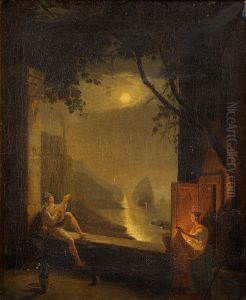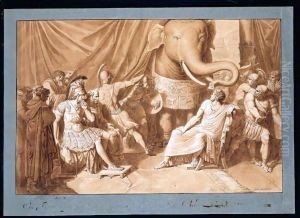Giuseppe Cammarano Paintings
Giuseppe Cammarano was a prominent Italian painter and scenographer who played a significant role in the Neoclassical and Romantic movements of the late 18th and early 19th centuries. Born in Sciacca, Sicily, in 1766, Cammarano embarked on a journey that would see him become one of the most celebrated artists of his time. His early years were marked by a rigorous study of the arts, initially under the guidance of his father, Felice Cammarano, a painter and decorator, which laid the foundation for his future successes.
Cammarano's career took a significant turn when he moved to Naples, a vibrant center for the arts during this period. There, he became a student at the prestigious Accademia di Belle Arti di Napoli, where he honed his skills and delved deeper into the study of classical art and mythology, themes that would prominently feature in his later works. His talent and dedication to his craft did not go unnoticed, and he soon began receiving commissions for both public and private projects, including religious and historical paintings, portraits, and scenography for theaters.
One of Giuseppe Cammarano's most notable contributions to the world of art was his work in scenography. He became the chief scenographer at the Teatro di San Carlo in Naples, one of the most famous opera houses in Italy. His innovative designs and use of perspective were revolutionary and greatly influenced the development of stage design in Italian theater. Cammarano's ability to create dramatic and visually stunning scenes added a new dimension to the operatic performances of his time, making them more immersive and emotionally impactful.
Throughout his life, Cammarano continued to paint, leaving behind a rich legacy of artworks that include frescoes, altarpieces, and canvases. His style evolved over the years, showing influences from both the Neoclassical and Romantic movements, yet always displaying his mastery of form, color, and composition. His works are characterized by their dramatic intensity, attention to detail, and the ability to convey deep emotional narratives, qualities that have ensured his place in the annals of art history.
Giuseppe Cammarano's influence extended beyond his lifetime, not only through his paintings and scenic designs but also through his teaching at the Accademia di Belle Arti di Napoli, where he nurtured the next generation of Italian artists. He passed away in Naples in 1850, leaving a lasting impact on the Italian art scene. Today, his works can be found in museums, galleries, and churches across Italy, celebrated for their beauty and historical significance.
















